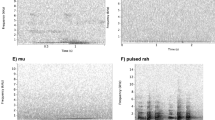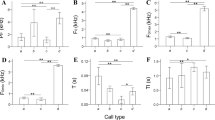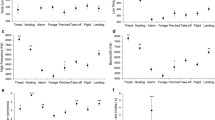Abstract
Animal vocal communication ranges from simple to complex based on repertoire size, structure and composition of calls and the information encoded in them. It is expected that social species will possess a functionally and structurally complex vocal repertoire. While several studies on mammalian systems exist supporting this, evidence from avian systems is comparatively limited. Towards this, we present evidence for complex acoustic communication in a cooperatively breeding passerine, Jungle Babbler. Jungle Babblers were found to possess a diverse vocal repertoire comprising 15 call types produced in either affiliative or agonistic context. These calls mediated the coordination of various social behaviours including group movement, foraging, brood care, aggression and vigilance. Yet, 8 out of 15 vocalizations were produced in the context of vigilance. This disproportionate investment of vocalizations towards coordinated acoustic vigilance is characteristic of many cooperatively breeding birds. Discriminant function analysis based on acoustic features verifies the classification of calls based on behavioural contexts. We also find evidence for the prediction that functionally similar calls are likely to be structurally similar as well. Multisyllabic calls were found to be composed of acoustically distinct notes that occur in a defined order in most cases. This implies that there may be underlying rules that determine call composition to give rise to functional calls to which receivers respond. Our study demonstrates that Jungle Babblers possess a structurally and functionally complex vocal repertoire. It also lays the foundation for future investigations on combinatorial and syntactical rules underlying call function and structure in bird vocalizations.
Significance statement
Studies on vocal complexity in birds have focussed mainly on repertoire size, structure and function. However, acoustic features of elements that constitute a call/song are rarely examined to evaluate vocal complexity. We examined complex communication in a cooperatively breeding social passerine, Jungle Babbler, for which we assessed repertoire size, function, acoustic features of calls and their constituent elements. Jungle Babblers were found to possess a functionally diverse vocal repertoire comprising 15 call types, 53% of which were in the context of vigilance. Discriminant function analysis based on acoustic features upheld the context-based call classification, implying that the calls were both functionally and structurally distinct. We also found that several calls were composed of multiple, acoustically distinct notes. These findings will be foundational in understanding the interrelations between sociality and communicative complexity and underlying combinatorial rules that determine call structure and function.



Similar content being viewed by others
Data availability
The datasets generated are available as supplementary material.
References
Altmann J (1974) Observational study of behavior: sampling methods. Behaviour 49:227–267
Andrews MI, Naik NM (1970) The biology of the jungle babbler. Pavo 8:1–34
Bates D, Maechler M, Bolker B, Walker S (2015) Fitting linear mixed effect model using lme4. J Stat Softw 67:1–48
Blumstein DT, Armitage KB (1997) Does sociality drive the evolution of communicative complexity? A comparative test with ground-dwelling sciurid alarm calls. Am Nat 150:179–200
Catchpole CK (1987) Bird song, sexual selection and female choice. Trends Ecol Evol 2:94–97
Catchpole CK, Slater PJ (2010) Bird song: biological themes and variations. Cambridge University Press, Cambridge
Crane JM, Savage JL, Russell AF (2016) Diversity and function of vocalisations in the cooperatively breeding chestnut-crowned babbler. Emu 116:241–253
Elie JE, Theunissen FE (2016) The vocal repertoire of the domesticated zebra finch: a data-driven approach to decipher the information-bearing acoustic features of communication signals. Anim Cogn 19:285–315
Engesser S, Ridley AR, Manser MB, Manser A, Townsend SW (2018) Internal acoustic structuring in Pied Babbler recruitment cries specifies the form of recruitment. Behav Ecol 29:1021–1030
Engesser S, Ridley AR, Townsend SW (2017) Element repetition rates encode functionally distinct information in pied babbler ‘clucks’ and ‘purrs’. Anim Cogn 20:953–960
Ficken MS, Ficken RW, Witkin SR (1978) Vocal repertoire of the Black-capped chickadee. Auk 95:34–48
Freeberg TM (2006) Social complexity can drive vocal complexity: group size influences vocal information in Carolina chickadees. Psychol Sci 17:557–561
Freeberg TM, Dunbar RI, Ord TJ (2012) Social complexity as a proximate and ultimate factor in communicative complexity. Phil Trans R Soc B 367:1785–1801
Gaston AJ (1977) Social behaviour within groups of Jungle Babblers (Turdoides striatus). Anim Behav 25:828–848
Gill FB (2007) Ornithology. Macmillan, New York
Greig E, Pruett-Jones S (2008) Splendid songs: the vocal behaviour of splendid fairy-wrens (Malurus splendens melanotus). Emu 108:103–114
Grieves LA, Logue DM, Quinn JS (2015) Vocal repertoire of cooperatively breeding smooth-billed anis. J Field Ornithol 86:130–143
Hailman JP, Ficken MS (1986) Combinatorial animal communication with computable syntax: chick-a-dee calling qualifies as “language” by structural linguistics. Anim Behav 34:1899–1901
Hiebert SM, Stoddard PK, Arcese P (1989) Repertoire size, territory acquisition and reproductive success in the song sparrow. Anim Behav 37:266–273
Hollén LI, Bell MB, Radford AN (2008) Cooperative sentinel calling? Foragers gain increased biomass intake. Curr Biol 18:576–579
Holt J, Barati A, McDonald PG (2017) The complex acoustic repertoire of a highly social species, the noisy miner, Manorina melanocephala. Emu 117:19–30
Kern JM, Radford AN (2013) Call of duty? Variation in use of the watchman’s song by sentinel dwarf mongooses, Helogale parvula. Anim Behav 85:967–975
Kondo N, Watanabe S (2009) Contact calls: information and social function. Jpn Psychol Res 51:197–208
Kottek M, Grieser J, Beck C, Rudolf B, Rubel F (2006) World map of the Köppen-Geiger climate classification updated. Meteorol Z 15:259–263
Krams I, Krama T, Freeberg TM, Kullberg C, Lucas JR (2012) Linking social complexity and vocal complexity: a parid perspective. Phil Trans R Soc B 367:1879–1891
Leavesley AJ, Magrath RD (2005) Communicating about danger: urgency alarm calling in a bird. Anim Behav 7:365–373
Leighton GM (2017) Cooperative breeding influences the number and type of vocalizations in avian lineages. Proc R Soc B 284:20171508
MacDougall-Shackleton SA (1997) Sexual selection and the evolution of song repertoires. Curr Ornithol 14:81–124
Magrath RD, Haff TM, Fallow PM, Radford AN (2015) Eavesdropping on heterospecific alarm calls: from mechanisms to consequences. Biol Rev 90:560–586
Manser MB (1999) Response of foraging group members to sentinel calls in suricates, Suricata suricatta. Proc R Soc Lond B 266:1013–1019
Manser MB (2001) The acoustic structure of suricates’ alarm calls varies with predator type and the level of response urgency. Proc R Soc Lond B 268:2315–2324
Marler P (1955) Characteristics of some animal calls. Nature 176:6–8
Marler P (1967) Animal communication signals: we are beginning to understand how the structure of animal signals relates to the function they serve. Science 157:769–774
Morton ES (1977) On the occurrence and significance of motivation-structural rules in some bird and mammal sounds. Am Nat 111:855–869
Naguib M, Mundry R, Ostreiher R, Hultsch H, Schrader L, Todt D (1999) Cooperatively breeding Arabian babblers call differently when mobbing in different predator-induced situations. Behav Ecol 10:636–640
Radford AN, Ridley AR (2008) Close calling regulates spacing between foraging competitors in the group-living pied babbler. Anim Behav 75:519–527
Ripley B, Venables B, Bates D, Hornik K, Gebhardt A, Firth D, Ripley MB (2013) Package ‘mass’. Cran R 538:113–120
Robinson CM, Creanza N (2019) Species-level repertoire size predicts a correlation between individual song elaboration and reproductive success. Ecol Evol 9:8362–8377
Rothstein SI, Yokel DA, Fleischer RC (1988) The agonistic and sexual functions of vocalizations of male brown-headed cowbirds, Molothrus ater. Anim Behav 36:73–86
R Core Team (2020) R: A language and environment for statistical computing. R Foundation for Statistical Computing, Vienna, Austria. https://www.R-project.org/
Searcy WA (1992) Song repertoire and mate choice in birds. Am Zool 32:71–80
Seddon N (2002) The structure, context and possible functions of solos, duets and choruses in the subdesert mesite (Monias benschi). Behaviour 139:645–676
Seddon N, Alvarez A, Tobias J (2002) Vocal communication in the pale-winged trumpeter (Psophia leucoptera): repertoire, context and functional reference. Behaviour 139:1331–1359
Seyfarth RM, Cheney DL, Marler P (1980) Monkey responses to three different alarm calls: evidence of predator classification and semantic communication. Science 210:801–803
Sommer C (2011) Alarm calling and sentinel behaviour in Arabian babblers. Bioacoustics 20:357–368
Templeton CN, Greene E, Davis K (2005) Allometry of alarm calls: black-capped chickadees encode information about predator size. Science 308:1934–1937
Warrington MH, McDonald PG, Sager AK, Griffith SC (2014) The vocal repertoire of the cooperatively breeding apostlebird (Struthidea cinerea). Emu 114:206–221
Weiss M, Hultsch H, Adam I, Scharff C, Kipper S (2014) The use of network analysis to study complex animal communication systems: a study on Nightingale song. Proc R Soc B 281:20140460
Wickler W (1985) Coordination of vigilance in bird groups: the “watchman’s song” hypothesis. Z Tierpsychol 69:250–253
Zeileis A, Hothorn T (2002) Diagnostic checking in regression relationships. R News 2:7–10
Zimmermann E, Lerch C (1993) The complex acoustic design of an advertisement calls in male mouse lemurs (Microcebus murinus, Prosimii, Primates) and sources of its variation. Ethology 93:211–224
Zuberbühler K (2002) A syntactic rule in forest monkey communication. Anim Behav 63:293–299
Acknowledgements
We are grateful to Jeff Podos and two anonymous reviewers who gave useful suggestions that helped improve the manuscript significantly. We acknowledge the help received from C.K. Vishnudas, Nakul, Ranjit, Gurtej and Sandeep towards mist-netting and banding. We thank Punjab Forest Department for providing all necessary permits for the study and Director, NIPER for approval to conduct fieldwork at NIPER campus. MJ is thankful to JB for cross-validating statistical analyses and is grateful to Tony Gaston for inspiring email discussions about Jungle Babblers in the initial years of the project.
Funding
The research was funded by a grant from the Science and Engineering and Research Board, Department of Science and Technology (YSS/2015/001606) to MJ and received infrastructural support from IISER Mohali. SDY and SC were supported by Senior Research Fellowships from the University Grant Commission, Government of India.
Author information
Authors and Affiliations
Contributions
MJ conceived and designed the study and secured funding for the work. SDY carried out all the field work and acoustic analyses for repertoire size, call characteristics and behavioural data. SC carried out all the field work and acoustic analyses for note-level complexity. SDY, SC and MJ carried out all statistical analyses and wrote the manuscript. All authors approved the final version of the manuscript.
Corresponding author
Ethics declarations
Ethics approval
Jungle Babblers are listed in Schedule IV under the Indian Wildlife Protection Act (1972) and designated as ‘Least Concern’ by IUCN’s Red List of Threatened Species. All applicable national and institutional guidelines for conducting a field study on animals were followed. Necessary permits were obtained from the Department of Forest and Wildlife Preservation, Government of Punjab, India (permit no. 3625) and the Institute Animal Ethical Committee (IISER/SAFE/PRT/2018/003), IISER Mohali, India. No animals were harmed or kept in captivity for this study.
Conflict of interest
The authors declare no competing interests.
Additional information
Communicated by J. Podos
Publisher’s note
Springer Nature remains neutral with regard to jurisdictional claims in published maps and institutional affiliations.
Rights and permissions
About this article
Cite this article
Yambem, S.D., Chorol, S. & Jain, M. More than just babble: functional and structural complexity of vocalizations of Jungle Babbler. Behav Ecol Sociobiol 75, 118 (2021). https://doi.org/10.1007/s00265-021-03018-z
Received:
Revised:
Accepted:
Published:
DOI: https://doi.org/10.1007/s00265-021-03018-z




